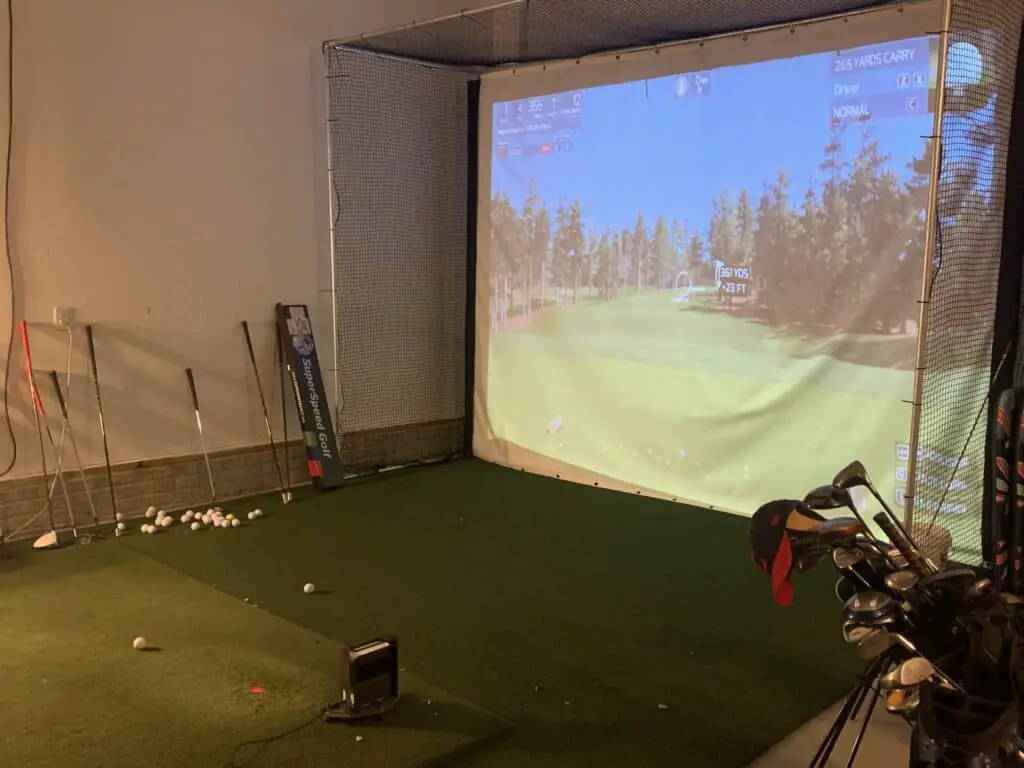There are two shots that end up left. The pulled shot and the overdrawn or hooked golf shot. The pulled shot is a result of a clubface that is aimed well left at impact. The overdrawn shot is a result of clubface and a swing path that has too large of a gap between the two.
Golf can be a complicated game!
It is even more complicated when we don’t have an idea if our golf ball is going to fly straight, left or right. And then to make it more difficult, we have to worry about which way it will curve?
What if you could learn a stock shot that gets your golf ball starting down a certain start line on a consistent basis with a predictable curve?
Below, I will dive into an explanation on why your irons go left. I will then dive into what swing issues cause that and the solution to fix each issue.
We will end with a great drill that will help you develop a stock shot, so you can finally play the consistent golf you dream of!
Why Do My Irons Go Left?
My Journey: Once I learned about the ball flight laws thanks to the Stack and Tilt instructors, golf become much more enjoyable and fixable. No longer did I have to question why certain things were happening and could use the ball flight laws to provide the science behind the club face and swing path interaction that was producing the ball flight I was seeing.
Let’s dive into more details.
First, we must understand the ball flight laws of golf. This will give clarity to the description above and help you understand the physics behind the issue before we dive in and give you some solutions and a drill to help fix it all!

TOPIC #1: Key Understanding On Why – The Golf Ball Flight laws
Here are some of the basics of the ball flight laws:
- The golf ball will start relative to the direction of the club face at impact.
- The golf ball will curve away from the swing path.
- So if your clubface is left of the swing path at impact, the ball will curve left. If your clubface is right of the swing path at impact, the ball will curve right.
With the pulled shot we have a clubface that is too closed at impact with a swing path that is also left or outside to in. The overdraw can have a clubface just about anywhere with a swing path that is too far right.
Hook vs Slice: What is the difference?
Here are some examples of a pulled or overdrawn shot in golf and the ball flight laws:
- Shot: Ball starts left and continues left. This is a clubface that is closed at impact with a path that is also left. Potential numbers could be a 7 degree closed club face with a 7 degree path outside to in or to the left. The clubface and swing path are somewhat aligned, but too far left to have an acceptable shot.
- Shot: Ball starts right and hooks left. This is a clubface that is open at impact with a swing path that is to the right of the clubface. Potential numbers could be a 3 degree open club face with a 10 degree swing path to the right. We have a gap of 7 degrees between clubface and swing path. This gap leads to the overdraw. If the golfer had a 3 degree open clubface with a 5 degree to the right swing path, the shot would actually work out in most cases.
Some key items to point out:
- If the curve is extreme, there is a large gap between your clubface and your swing path.
- If the curve is soft, there is a small gap between your clubface and your swing path.
- Arguably the most difficult shot to hit in golf is the straight shot. This requires a perfectly square clubface with a 0 degree path.
- The slice is a result of too large of a gap between the clubface and swing path.
While we don’t promote the perfectly straight shot in golf, too large of a gap between clubface and swing path is difficult to control and manage. The opposite of the slice is the hook and has the opposite numbers of the slice and is a shot that many low level handicap golfers struggle with. The pulled or pushed shot have a small gap between path and clubface but are both too far right or too far left.

TOPIC #2: Swing Issues and Solutions
Swing Issue #1: Body Stalling. When a golfer hits a pulled or overdrawn shot, it could be the result of the body failing to get completely through the shot. As a result, the golfer has to try to time it up with the hands and on occasion will hit a pulled shot as a result of shutting down the face too quickly with the hands.
Solution #1: Out of the way, out of the way. This is a great swing thought for this issue. Think about a complete turn back and then a complete turn through. Shawn Clement will often stress getting out of the way so your arms don’t run into your body on both the backswing and the downwing. Below is an excellent video on this swing fault and the solution.
Swing Issue #2: Sliding Hips. This shot is more common with the overdraw or the hook. In an effort to swing through the shot, the golfer slides his or her hips excessively forward. This will often go through the swing path too far inside, causing a large gap between the clubface and the swing path, leading to the overdraw.
Solution #2: Down and Rotate. The golfer can get the feel of lifting up slightly in the backswing, sitting or squatting as the first move in the downswing and then clearing out of the way. The arms will follow and should be more soft through the shot. This will allow the body and the club to get through the shot. Here is another Shawn Clement video to help out!
Swing Issue #3: Over the top move. Some golfers will fire right away from the top, causing an over the top move and a swing path that is too far left. If the golfer matches up the clubface, they will hit a massive pull shot.
Solution #3: Be patient. Use the same squatting motion as above and let the arms come down naturally, before turning and rotating through the shot. The golfer who tries to be too forceful from the top is going to struggle grealy with the pull shot or the slice shot in golf.
Topic #3: Excellent Drill For All Golfers!
Amazing Drill: The Stock Shot Drill
One of my go to drills for golfers of all skill levels. The key is to develop a consistent start line and curve of the golf ball! When we can do that, we can manage our game better and plot our way around a golf course!
- At the driving range, set up an alignment stick about 6-8 yards in front of you, straight down your target line.
- If you have a second alignment stick, set the stick 3-4 feet right of the first stick (for a draw) or left of the first stick (for a fade).
- Complete your initial assessment see how many times out of 10 you can start the ball to the right or left of your target. Pick one side and measure your game at this point.
- The goal is to eventually get 7 out of 10 shots to start to the correct side and draw back towards the target.
We believe the swing path is only 2nd in importance to the clubface in the golf swing.
Check out this post: What is the most important part of the golf swing?
Whether you choose to play a draw or a fade, it doesn’t matter. The key is to be able to hit your start line and have a predictable curve.
We believe in 3 keys to the golf swing:
- The golfer must be able to control the low point (quality of ball contact).
- The golfer must be able to hit a start line and have a predictable curve (stock shot drill).
- The golfer must have enough speed to play the course (distance).

Final Thoughts: Have Fun!
The journey in golf is supposed to be fun. Trying and working to develop a stock shot can lead to more stress free and fun rounds. I really enjoy the practice portion and working on little minor adjustments to get that stock shot back on line and hit consistent shot patterns time and time again.
Wish you hit the ball further? Here are two great resources:
My Secret To Golf Improvement
Let’s face it, in order to get really good at golf, we must practice frequently. About four years ago, I made the leap and invested in a golf simulator build for my garage. I went with a SkyTrak Launch Monitor and the TGC software and can now play over 100,000 courses including Augusta, Pebble Beach, Bethpage Black, Whistling Straits. St. Andrews and many other of the top 100 courses in the world.
This golf simulator setup, which is more affordable that you might imagine, has been a game changer. I can now play golf everyday of the year regardless of rain, snow, cold weather or time of day. I can practice or play rounds of golf. I can stand in the 11th fairway at Augusta and with the auto-rewind feature I am able to practice my approach shots from various differences.
It is worth checking out through Rain or Shine Golf as they offer some incredible packages along with financing offers that are difficult to beat.
Some direct links to Rain or Shine Golf for pricing and financing:
Take Action – What You Can Do Today to Get Better
What does this mean for you? I believe in the following recipe to get better:
1 – Improve your motion in the golf swing by identifying a golf instructor. Here are some options:
Here is a list of golf instructors that we have reviewed:
2 – Train to swing faster and improve your swing speed. Here are some options:
Looking to gain more Speed and Distance in your swing. Two Options:
3 – Understand course strategy and work to break through your next barrier. Here is a series on breaking through:
We have provided guides on how to break 100, 90, 80 and 70. Check out more below, if interested.
4 – Practice Frequently
Did you know that I build a golf simulator in my garage and have played over 500 rounds of golf on my SkyTrak system? It has been a game changer and one worth checking out. Here are some of my other posts on golf simulators frequently asked questions:
- Is a Golf Simulator Worth It?
- How to Build a Golf Simulator?
- What is the Best Golf Simulator?
- Golf Simulator Accessories?
- How to Build a Golf Simulator for under $7000
- Top 11 Reasons to Buy a SkyTrak
- How to Build a Golf Simulator for Under $1000
- Why Build A Golf Simulator?
- What Space is Needed?
- Can A Golf Simulator Improve My Game?
- How Much Does A Golf Simulator Cost?
- Don’t Forget to Check out our 15 best golf swings of all time.
